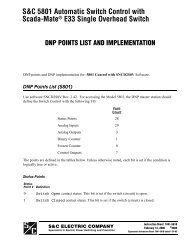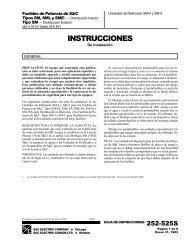Descriptive Bulletin 811-30 - S&C Electric Company
Descriptive Bulletin 811-30 - S&C Electric Company
Descriptive Bulletin 811-30 - S&C Electric Company
Create successful ePaper yourself
Turn your PDF publications into a flip-book with our unique Google optimized e-Paper software.
<strong>Descriptive</strong> <strong>Bulletin</strong> <strong>811</strong>-<strong>30</strong>September 11, 2006Supersedes <strong>Descriptive</strong> <strong>Bulletin</strong> <strong>811</strong>-<strong>30</strong> dated 5-12-03 © 2006
S & C E L E C T R I C C O M P A N YHere Are Five Reasons Why Loadbuster Is the Better Way:1 RangeS&C’s Loadbuster—unlike loadbreak cutouts or hookstick-operated interrupter switches—brings loadswitching capability through 34.5 kV and 600 amperes nominal, 900 amperes maximum to your overheaddistribution system. You can even switch ungrounded transformers at 27 kV or 38 kV. No longer must you laborunder the assumption of a limited voltage or current spectrum for load-switching devices on your distributionsystem. And with Loadbuster, the dollar savings are big.234Greater Flexibility . . . at Lower CostHaving an arc-interrupting means built into every disconnect, cutout, power fuse, fuse limiter, and dropoutrecloser on your overhead distribution system is a prohibitive luxury—it simply costs too much. S&C’sLoadbuster gives you the operating flexibility of a system with multipoint interrupter switches—but withoutthe cost.How? Loadbuster—S&C’s portable loadbreak tool—brings the interrupterto the disconnect, cutout, power fuse, fuse limiter, or dropout recloserwhenever loadbreak switch capability is needed . . . instantly. Butonly when needed. The rest of the time, these S&C Loadbusteroperabledevices remain matched to the economics of the system.Loadbuster is S&C’s unique method of providing low-cost,positive, and convenient load-switching capability for devicesdesigned for Loadbuster operation.The concept is simple. The advantages are many. The beauty ofit all is that Loadbuster can be instantly reset for repeated use . . .so you limit your investment to only one Loadbuster Tool for eachline truck, you spread an acceptable minimal cost across your system,and you can move quickly to restore service to power consumers.There are two ways toperform single-phase liveswitching on a distributionsystem . . . interrupter-equippedcutouts and disconnects.Or the better way: S&C’sportable loadbreak tool:Loadbuster.Power Consumers Benefit with LoadbusterNo one likes to be without electric power. And most power consumers cannot tolerate prolonged outages . . .not even short breaks in service.Loadbuster switching helps keep service interruptions to a minimum. There’s no need for complexswitching procedures involving opening and reclosing of line and feeder breakers to permit dead switching.There’s no need for one or more line crews to travel and retravel miles of system. Loadbuster makes everydisconnect, cutout, power fuse, fuse limiter, and dropout recloser a sectionalizing point. Live switching canbe done at the point that minimizes the length of planned outages and/or the point where the fewest powerconsumers will be affected.Operating Personnel Like LoadbusterLoadbuster is easy to operate. Loadbuster’s anchor is simply hung on the attachment hook of thedisconnect, cutout, power fuse, fuse limiter, or dropout recloser. Then the pull-ring is engaged withLoadbuster’s pull-ring hook, held fast by the pull-ring latch (see page 6). A firm, steady downward pull opensthe device and trips Loadbuster, breaking the circuit. There’s no external arc, no contact burning.Loadbuster-operable devices have no dubious arc chutes, auxiliary blades, or mechanisms to concernoperating personnel. And, being portable, Loadbuster is always available for easy inspection. A minimum ofattention assures operating personnel that it’s in top-notch condition.2
S & C E L E C T R I C C O M P A N Y5Universality — Loadbuster Does More Than Switch LoadIn combination with portability, another concept, universality, has been embodied in Loadbuster.Not only can Loadbuster switch load currents up through 600 amperes nominal, 900 amperesmaximum at distribution system voltages up through 34.5 kV . . . it can break the associatedtransformer-magnetizing currents, line-charging currents, and cable-charging currents. And it can switchsingle capacitor banks typically found on distribution systems within its voltage rating, as spelled out in thetable on page 4. Certain restrictions apply . . . see the limitations on page 5.Loadbuster brings switching capability to suitably “hook-equipped” disconnects, cutouts, power fuses,fuse limiters, and dropout reclosers. It thus eliminates the need for loadbreak cutouts or hookstick-operatedinterrupter switches . . . even group-operated disconnects or interrupter switches where group operation isunnecessary.LoadbusterCatalog Number 5<strong>30</strong>0R3Rated: 14.4/25 kV Nominal27 kV MaximumLoadbusterCatalog Number 5400R3Rated: 25/34.5 kV Nominal38 kV MaximumOptional Carrying CaseDouble-wall, high-density polyethylene constructionprovides extraordinary protection for Loadbuster.3
S & C E L E C T R I C C O M P A N YLoadbuster Switches a Wide Range of DevicesConsidering its universality and switching capabilities,Loadbuster’s “easy-to-operate” design is all the moreremarkable. Loadbuster can be used with all hookequippeddistribution devices—including disconnectsand cutouts not manufactured by S&C—when theyqualify for switching with Loadbuster. See thequantitative requirements outlined on page 8.Switching a DisconnectLoadbuster Catalog Number5400R3 used with a34.5-kV CrossarmInverted StyleLoadbuster Disconnect ®Switching a CutoutLoadbuster CatalogNumber 5<strong>30</strong>0R3 and25-kV Ultra-Heavy-DutyOverhead Pole-TopStyle S&C Type XSCutout are a perfectmatch for protection andswitchingSwitching a Power FuseLoadbuster CatalogNumber 5400R3 bringsswitching capability toa 25-kV OverheadPole-Top StyleS&C Type SMD-20Power FuseSwitching an S&C Fault Tamer ®Fuse LimiterLoadbuster Catalog Number 5<strong>30</strong>0R3is shown here switching a 15-kVS&C Fault Tamer Fuse LimiterSwitching an S&C TripSaver Dropout RecloserLoadbuster Catalog Number 5<strong>30</strong>0R3applied with 15-kV Branch-FeederStyle TripSaver Dropout RecloserSwitching RatingsLoadbuster is available in two easy-to-use models:Catalog Number 5<strong>30</strong>0R3, rated 14.4/25 kV nominal,27 kV maximum; and Catalog Number 5400R3, rated25/34.5 kV nominal, 38 kV maximum. Both have a50/60-hertz interrupting rating of 600 amperes nominal,900 amperes maximum. When used with suitably“hook-equipped” disconnects, cutouts, power fuses,fuse limiters, and dropout reclosers, Loadbuster issuitable for these live-switching duties on singlephaseor three-phase circuits of overhead distributionsystems through 34.5 kV:Transformer switching – Loadbuster can switch transformerload currents up through 600 amperesnominal, 900 amperes maximum, as well as transformermagnetizingcurrents associated with the applicableloads.Line switching – Loadbuster may be used for load splitting(parallel or loop switching) and load dropping ofcurrents up through 600 amperes nominal, 900 amperesmaximum. It is also capable of line dropping (chargingcurrents typical for distribution systems of thesevoltage ratings).Cable switching – Loadbuster is suitable for load splitting(parallel or loop switching) and load dropping ofcurrents up through 600 amperes nominal, 900 amperesmaximum. It may also be used for cable dropping(charging currents typical for distribution systems ofthese voltage ratings).Capacitor bank switching – Loadbuster can switch singlecapacitor banks to the extent reflected in the tablebelow.Capacitor-Bank Switching CapabilityLoadbusterCatalogNumber5<strong>30</strong>0R35400R3NominalSystemVoltage, kV,Three-Phase12–14.41620.8–23.924.9 and 2620.8–23.924.9 and 2627.634.5Maximum Capacitor Bank Rating,kVAC, Three-PhaseSolidly or EffectivelyGrounded SystemSingle1Banks,Grounded-Wye Connected18002400<strong>30</strong>003600<strong>30</strong>00360036004800Single1Banks,Ungrounded-Wye Connected18002400dd<strong>30</strong>0036003600dUngroundedSystemSingle1Banks,Grounded- orUngrounded-Wye Connected18002400dd<strong>30</strong>0036003600d1 Loadbusters must not be used for switching parallel (“back-toback”)capacitor banks.d Loadbusters must not be used for switching ungrounded-wyeconnected banks—or grounded-wye connected banks on ungroundedsystems—where maximum system operating voltage exceeds 18 kV forLoadbuster Catalog Number 5<strong>30</strong>0R3, or 29 kV for Loadbuster CatalogNumber 5400R3.4
S & C E L E C T R I C C O M P A N YA Note on Single-Pole SwitchingIn single-pole switching of ungrounded-primarythree-phase transformers or banks (or single-phasetransformers connected line-to-line), circuit connectionsor parameters may, in some cases, produce excessiveovervoltages. In particular, for the following applicationsabove 22 kV, single-pole switching by any means—including Loadbuster—should be performed onlyunder the conditions stated in italics:h For unloaded or lightly loaded delta-connected orungrounded-primary wye-wye connected three-phasetransformers or banks (or line-to-line connected singlephasetransformers), rated 150 kVA or less three-phase,or 50 kVA or less single-phase—or of any kVA ratingwhen combined with unloaded cables or lines—wheremaximum system operating voltage exceeds 22 kV.Single-pole switching should be performed only if eachphase is carrying 5% load or more, or if the transformeror bank is temporarily grounded at the primary neutralduring switching.h For loaded or unloaded ungrounded-primary wye-deltaconnected three-phase transformers or banks—aloneor combined with unloaded cables or lines—wheremaximum system operating voltage exceeds 22 kV.Single-pole switching should be performed only if eachphase is carrying 5% load or more and if the lightingloadphase is always switched open first (or switchedclosed last); or if the transformer or bank is temporarilygrounded at the primary neutral during switching.Operating LifeLoadbuster is a sturdy and reliable tool that will provideyears of excellent service. Only a minimum of attentionis required to keep it in top-notch operating condition.Inspection intervals are dictated by the number of operations—asindicated on the operation counter—and theseverity of switching duties. Aside from the counter reading,there are no audible or visible signals to indicate theneed for attention.From 1,500 to 2,000 Loadbuster operations maynormally be expected between required inspections,based on typical usage involving a mixture of variedswitching duties. Included in these duties are switchingof line-charging currents, transformer-magnetizingcurrents, pole-top capacitor-bank currents, and moderateparallel or loop load currents, with only occasionalswitching of heavier load currents. Only if Loadbusteris used primarily for switching of load currentsapproaching the rating of the tool will more frequentinspections be required.Benchmarks indicating the need for replacementof Loadbuster parts include the degree of erosion ofthe trailer portion of the moving contact assembly andthe condition of its flexible cable. The simplicity ofLoadbuster inspection and the ease of parts replacementare described in Loadbuster Instruction Sheet <strong>811</strong>-505.Limitations on Use1. Loadbusters must be used only with disconnects, cutouts,power fuses, fuse limiters, or dropout recloserswhich meet S&C’s applicable minimum constructionspecifications found in the current revision of Data<strong>Bulletin</strong> <strong>811</strong>-60.2. Loadbuster Catalog Number 5400R3, rated 25/34.5 kV,must not be used with metal-enclosed switchgear,metal-enclosed switches or fuses, or pad-mountedgear, of any make.3. Although the interrupting ratings of LoadbusterCatalog Number 5400R3, rated 25/34.5 kV, are equallyapplicable at lower voltages, it must not be used withthe following devices, since the fuse tube or bladetravel of such devices is too short to accommodateLoadbuster’s operating stroke:(a) Cutouts, power fuses, fuse limiters, or dropoutreclosers of any make, rated 110 kV BIL or less;(b) Disconnects, cutouts, power fuses, fuse limiters,or dropout reclosers of any make, rated 7.2/14.4kV, 7.8/13.8 kV, 8.25 kV, or less;(c) Disconnects of any make, rated 125 kV BIL orless;(d) Discontinued Station Style S&C Type XS FuseCutout Catalog Number 189131 (with or withoutcatalog number supplements).4. Loadbuster must not be used in applications wheremaximum system operating voltage exceeds theLoadbuster’s maximum voltage rating.5
S & C E L E C T R I C C O M P A N YSwitching with Loadbuster Is Easily Learned . . . It’s as Easy as One-Two-ThreeLoadbuster is light in weight and simple to operate. Itenables you to open disconnects, cutouts, power fuses,fuse limiters, and dropout reclosers quickly and easily.Just position Loadbuster across the front of the device,with the tool’s anchor placed on the attachment hook onthe far side of the device. Engage Loadbuster’s pull-ringhook on the pull-ring of the blade or fuse tube; it’s heldfast by the tool’s pull-ring latch. As the universal poleis pulled downward with a firm, steady stroke—andLoadbuster is extended to its maximum length—thedevice is opened; current is simultaneously divertedthrough Loadbuster . . . at the same time Loadbuster’sinternal operating spring is charged. At a predeterminedpoint in Loadbuster’s operating stroke, its internal triggertrips, the charged operating spring is released, internalcontacts are separated, and the circuit is positively interrupted.The only sound is that of Loadbuster tripping.Circuit interruption is independent of the speed withwhich Loadbuster is operated. All that’s required is asmooth operating stroke, without hesitation or jerking. . . until the tool is extended to its maximum length.The resetting latch retains the tool in the open positionfor removal from the device and until released to resetLoadbuster for its next operation.Resetting Loadbuster is easy too. Release theresetting latch and firmly close the tool to its fullytelescoped position until the orange band on the innertube assembly is no longer visible. Then extend the toolabout three inches and let it snap back to verify springtension.NOT RESETRESETSwitching a Disconnect f Switching a Fuse Cutout a ,Power Fuse, Fault Tamer FuseLimiter, or TripSaver DropoutRecloser1 AttachReach across the front of the device andattach Loadbuster’s anchor to the attachmenthook on the far side. Then engage thedevice’s pull-ring with Loadbuster’s pullringhook. Loadbuster’s pull-ring latchprevents inadvertent disengagement of thepull-ring and pull-ring hook.2 PullA firm, steady downward pull onLoadbuster—to its maximum extendedlength—opens the device in the normalmanner, as the current is diverted throughLoadbuster. At a predetermined point in theopening stroke, Loadbuster trips, breakingthe circuit positively.3Roll OffLoadbuster is disengaged by first removingits anchor from the device’s attachmenthook. Then, with the blade or fuse tube in thefully open position, Loadbuster is removedfrom the pull-ring with a simple “roll-off”motion.f 34.5-kV Crossarm Inverted Style S&C Loadbuster Disconnect shown.a 25-kV Ultra-Heavy-Duty Overhead Pole-Top Style S&C Type XS Cutoutshown.6
S & C E L E C T R I C C O M P A N YThis Is How Loadbuster Works1 Loadbuster Provides a Current Pathbetween the upper contact and the pull-ring of thedisconnect, cutout, power fuse, fuse limiter, or dropoutrecloser, as indicated by the solid red line. Note the pointsof similarity to the interrupting unit of a conventionalload-interrupting device: the moving contact, stationarycontact, arc-extinguishing chamber, and trailer.2When Loadbuster Is Extendedby a firm, steady downward pull on the universal pole,the disconnect, cutout, power fuse, fuse limiter, or dropoutrecloser is opened; the current is diverted throughthe tool (along the current path represented by the solidred line); and the internal operating spring is charged.At a predetermined point in the opening stroke, thetrigger inside the tool trips, releasing the charged springto effect high-speed separation of the moving contactfrom the stationary contact.3The Current Is Positively Interruptedby rapid elongation of the arc confined within the arcextinguishingchamber, in the narrow annular spaceformed between the trailer and the liner—and by theefficient deionizing action of the gases yielded by thesurrounding materials of the trailer and the liner.In the maximum extended position, pictured here, anisolating gap is established (where the broken, shadedred line is parted) within the arc-extinguishing chamber.The resetting latch retains the tool in this open positionuntil released to reset Loadbuster for its next operation.1 2 3Loadbuster’s pull-ringhook makes mechanicaland electrical connectionwith pull-ring ofdevice being switchedLoadbuster’s anchormakes mechanical andelectrical connectionwith attachment hookon upper contact ofdevice being switchedResettinglatchTrailerSpringMoving contactassemblyLoadbuster’spull-ring latchprevents pull-ringhook from inadvertantlydisengagingdevice’s pull-ringStationarycontactassemblyArc-extinguishingchamberTriggerLiner7
S & C E L E C T R I C C O M P A N YSelecting a Disconnect, Cutout, Power Fuse, Fuse Limiter, or Dropout RecloserHere’s what to look for when selecting a disconnect,cutout, power fuse, fuse limiter, or dropout recloser tobe switched with Loadbuster:h There must be an attachment hook at the upper (jaw)end of the device, over which Loadbuster’s anchorcan be hooked; and a pull-ring on the device’s switchblade or fuse tube which can be readily engagedwith Loadbuster’s pull-ring hook and held fast by thepull-ring latch.h The device must mechanically coordinate withLoadbuster’s operating sequence such that (a) engagementof Loadbuster will not cause or allow the switchQuantitative Requirements for Devices Qualifying for Use with Loadbusterblade or fuse tube to drop open prematurely and (b)the attachment hook will keep Loadbuster positivelyanchored until tripping occurs, while (c) permittingeasy removal of Loadbuster whether the openingstroke has been completed or whether, for any reason,the device being switched has been reclosed afterpartial (incomplete) opening.h The device must be capable of easy, positive manipulationwith Loadbuster from all practical angles anddirections—and in all mounting positions intendedor the device—while maintaining the minimummechanical and electrical requirements, as listed in thetable below.I II III1 IV6 V7LoadbusterCatalog NumberDisconnect, Cutout,Power Fuse, Fuse Limiter,or Dropout RecloserApplication—Max SystemOperating Voltage,Three-PhaseMinimum Dry Withstand VoltagesAcross External Disconnect Gap260-Hertz3–atTime of Tripping4CapacitanceSwitching Test5–Circuit VoltageSuggested MinimumExternal DisconnectGap Separation2at Time of Tripping4Suggested MinimumExternal DisconnectGap Separation2with LoadbusterFully Extended to“Latched-Open” PositionkV kV, RMS kV, RMS Inches (mm) Inches (mm)5<strong>30</strong>0R3 9 18 9 3¹⁄₂ (89) 4 (102)5<strong>30</strong>0R3 & 5400R3 15 <strong>30</strong> 15 3¹⁄₂ (89) l 3⁷⁄₈ (99)d 4¹⁄₂ (115)l 5 (127)d5<strong>30</strong>0R3 & 5400R3 18 36 18 3⁷⁄₈ (99) 5 (127)5<strong>30</strong>0R3 & 5400R3 27 41 l 54d 20.5 l 27d 3⁷⁄₈ (99)d 4³⁄₄ (121)d 5 (127)l 6 (153)d5400R3 29 a 29 5¹⁄₄ (134) 6¹⁄₂ (166)5400R3 38 a 29 5¹⁄₄ (134) 6¹⁄₂ (166)1 Disconnects, cutouts, power fuses, fuse limiters, or dropout reclosers(while being switched with Loadbuster) must be capable of withstandingat least one of these tests without flashover, preferably with the mountingbracket or base of the device under test grounded. However, in the caseof devices with insulation just meeting minimum ANSI standards, it maybe necessary to test with mounting bracket or base floating. The specifiedvoltages are given for standard atmospheric conditions of temperature,barometric pressure, and humidity, and must be corrected for the existingatmospheric conditions at the time of test.2 Between all live parts of the combination of Loadbuster and disconnect,cutout, power fuse, fuse limiter, or dropout recloser for the mostunfavorable practical operating position of Loadbuster.3 These minimum voltages must be applied for a period of 10 seconds. Thevoltage shall be applied starting at 75% of the ultimate value and raised tothe listed test voltage at a constant rate such that the test voltage is reachedin not less than 5 seconds nor more than 10 seconds. An appropriatelycalibrated means must be used to measure the voltage.4 Tripped condition is simulated when Loadbuster Catalog Number5<strong>30</strong>0R3 is telescoped to 1⁷⁄₈ inches (48 mm) from “latched-open” position,or when Loadbuster Catalog Number 5400R3 is telescoped 1³⁄₈ inches(35 mm) from “latched-open” position.5 This test consists of interruption of a 0% PF leading capacitance currentof 2 to 5 amperes with Loadbuster used in the most unfavorable operatingposition. The test circuit is to be energized by a 60-hertz source at the voltagespecified. A test series of 20 successive operations must be performedwithout flashover across the external disconnect gap.6 These dimensions are approximately those required to meet thevoltages specified in Column III. They are based on designs where sharppoints, sharp edges, protrusions, etc., are avoided so that essentiallyrod-gap configuration is obtained on disconnect, cutout, power fuse,fuse limiter, or dropout recloser contacts. Sharp points, edges, etc., mayrequire minimum gaps measuring as much as 25% greater than the dimensionslisted to achieve the same dry withstand values.7 These dimensions permit Loadbuster to be removed without reducingthe gap below the values listed in Column IV, and should be maintainedafter circuit interruption (even though the transient recovery voltage maynot then be a factor) to provide margin for possible inattentive manipulationof Loadbuster.l Loadbuster Catalog Number 5<strong>30</strong>0R3.d Loadbuster Catalog Number 5400R3.a Loadbuster should not be subjected to sustained 60-hertz voltage ofthe value that would be required for this test. Only the “CapacitanceSwitching Transient” test (column at right) is applicable at this voltage.S&C ELECTRIC COMPANYSpecialists in <strong>Electric</strong> Power Switching and ProtectionOffices Worldwidewww.sandc.com • Telephone: (773) 338-1000 • Fax: (773) 338-3657Printed in U.S.A.



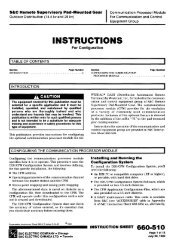
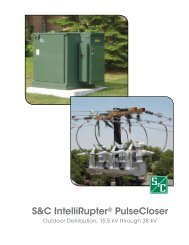
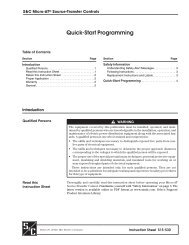
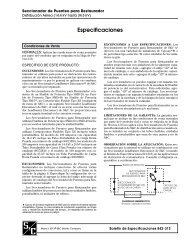
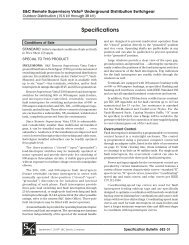


![Boletin Descriptivo 851-30S [Spanish, 3 MB, 12/20/2004]](https://img.yumpu.com/49573007/1/190x245/boletin-descriptivo-851-30s-spanish-3-mb-12-20-2004.jpg?quality=85)
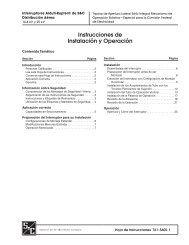
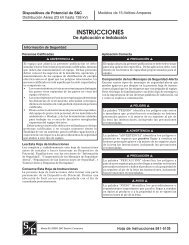
![Boletin de Especificaciones 771-31S [Spanish, 2 MB, 8/30/2010]](https://img.yumpu.com/48742025/1/190x245/boletin-de-especificaciones-771-31s-spanish-2-mb-8-30-2010.jpg?quality=85)
